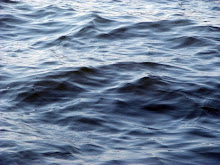 Rafting up for a group photo, Left to right, Ned Asplundh in his Sea Pearl, Jim Luton in his crabbing skiff, Marsh Cat Obadiah, sans skipper Pete Peters who is doing the honors, Mike Wick in his melonseed cat Pepita (a John Brady design), Ron Gibbs in his Celebrity class, Doug Oeller and NealBattaler in another Marsh Cat (both of these cats are, I believe, Joel White designs), and Kevin Brennan and Peter Digel in the Welsford Navigator Slip Jig.
Rafting up for a group photo, Left to right, Ned Asplundh in his Sea Pearl, Jim Luton in his crabbing skiff, Marsh Cat Obadiah, sans skipper Pete Peters who is doing the honors, Mike Wick in his melonseed cat Pepita (a John Brady design), Ron Gibbs in his Celebrity class, Doug Oeller and NealBattaler in another Marsh Cat (both of these cats are, I believe, Joel White designs), and Kevin Brennan and Peter Digel in the Welsford Navigator Slip Jig.Tuesday, July 28, 2009
Chesapeake Float
 Rafting up for a group photo, Left to right, Ned Asplundh in his Sea Pearl, Jim Luton in his crabbing skiff, Marsh Cat Obadiah, sans skipper Pete Peters who is doing the honors, Mike Wick in his melonseed cat Pepita (a John Brady design), Ron Gibbs in his Celebrity class, Doug Oeller and NealBattaler in another Marsh Cat (both of these cats are, I believe, Joel White designs), and Kevin Brennan and Peter Digel in the Welsford Navigator Slip Jig.
Rafting up for a group photo, Left to right, Ned Asplundh in his Sea Pearl, Jim Luton in his crabbing skiff, Marsh Cat Obadiah, sans skipper Pete Peters who is doing the honors, Mike Wick in his melonseed cat Pepita (a John Brady design), Ron Gibbs in his Celebrity class, Doug Oeller and NealBattaler in another Marsh Cat (both of these cats are, I believe, Joel White designs), and Kevin Brennan and Peter Digel in the Welsford Navigator Slip Jig.Tuesday, July 21, 2009
Tucker Silhouette on ebay


 This is an excellent chance to buy a classic Hurley built Robert Tucker designed Silhouette on ebay. Located Seattle area. I'd buy her myself if Seattle wasn't so far away or if I'd the dollars to ship. Bid right now is $225, but not much time left. For more, click title or go here. Someone please save this little gem. These rarely surface in the US.
This is an excellent chance to buy a classic Hurley built Robert Tucker designed Silhouette on ebay. Located Seattle area. I'd buy her myself if Seattle wasn't so far away or if I'd the dollars to ship. Bid right now is $225, but not much time left. For more, click title or go here. Someone please save this little gem. These rarely surface in the US.
Monday, July 20, 2009
Skin and Bones

Entering

The Exhibition

This vitrine shows a typical set of onboard tattoo making tools

An image of Lady Liberty greets the visitor as you enter the show.

The original can be found on the ditty box on the left

Another example of sailors craft, here sailwork from the early 20th C.

Samoan tattoo tools

Image of an early Pictish warrior, with full body tattoos

A tattoo artist's box, with a rather nice painting

The exhibit uses many examples of sailors art to show how tattoos would have looked.

Here's a close up

This little bag serves the same purpose, and like many of the objects in the show, is exquisite.

Tattoo artists created 'flash books' of their designs to inform the sailors of the available designs. The museum created duplicate flash books for the visitor to thumb through.

This large ceremonial razor was to commemorate a 'Crossing of the Line" ie: the Equator, usually presented at a day long festivity which involved ritual indignation's directed at the novice 'Pollywogs' as part of being imitated into the veteran 'Shellbacks' .

An example of a document of passage presented at such a ceremony. This one invokes Rex Neptunis, king of the sea.

Here we see the tools of the electric tattoo artist, Cap'n Bill Coleman. Electric tattooing began in 1891 with artist and inventor Sam O'Riellly. Colemans kit includes early electric needles, dry pigments which were mixed with alcohol and a small statue which depicted an array of designs as a full body of tattoo.

A poster of designs

Tattoo magic. In a delightful interactive display, this cutout tattoo artist will draw with light one of the four designs seen above the table.
He'll also solicit your business.

Here a very young sailor gets a light tatoo announcing that she has sailed 5000 miles, the swallow design.

A little more revealed

Viola!

A continuing legacy
Monday, July 13, 2009
Minimalist Cruising 9.1:Buttercup


Following up on my recent post about a design I am thinking about, Mike Wick of the TSCA Delaware River Chapter sent me this article about a small twin keeler from 1937, Buttercup. Designed by Robert Clark, built by Rowhedge Ironworks, Essex, England. Commissioned and owned by Charles E. Foster. The article is either from the Rudder or Yachting Monthly, I'm not sure which. She was dubbed the sailing sausage, but by all accounts performed admirably. I wrote Gavin Atkin of intheboatshed asking whether he knew any more about this design. He sent me this from Andy Cunningham of Cunningham Marine a great article on twin keels. The design anticipates the Uffa Fox Atalanta which I wrote about earlier. It also anticipates much of the postwar British investigation of small twin keel cruising boats, about which much more later. If anyone has readable photos of this boat, please share!
Monday, July 6, 2009
Anniversary

John Frederick Kensett, Eaton's Neck

John Frederick Kensett

John Frederick Kensett, On The Coast, 1870

John frederick Kensett, The Coast of Newport, 1858

James McNiell Whistler, Symphony in Grey and Green the Sea

Whistler

Whistler, Nocturne

Whistler, The Sea

Whistler, Nocturne in Blue and Silver, Cremornel Lights

Whistler

Whistler, Nocturne River Battersea

Whistler

Whistler, The Sea, Pourville

Whistler

Whistler

Whistler

Whistler

Whistler
Sorry about credits and attributions, even titles, many misplaced.
Subscribe to:
Comments (Atom)


















2.JPG)




















